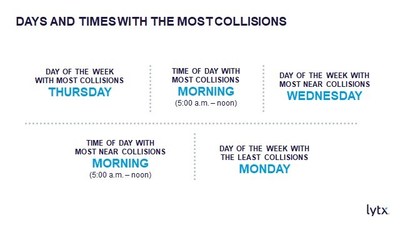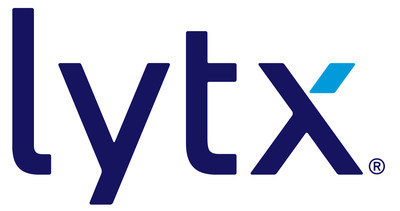|
06.10.2019 20:00:00
|
Lytx Second Annual "State of the Data" Report Highlights Top Trends in Truck Driving Safety and Risk
SAN DIEGO, Oct. 6, 2019 /PRNewswire/ -- Lytx®, a leading global provider of machine vision and artificial intelligence-powered video telematics solutions for commercial and public sector fleets, today shared its second annual "State of the Data" presentation at the American Trucking Associations Management Conference and Exhibition (ATA MC&E), the premiere meeting for trucking professionals. Based on more than 6.2 billion miles of driving data from Lytx trucking clients this year alone, the presentation highlights noteworthy trends in truck-driving safety and concentrated areas of risk.

"For the second year in a row, we put our more than 100 billion miles of driving data under the microscope to uncover new insights at ATA MC&E that will help trucking fleets of all sizes improve safety and their bottom lines," said Brandon Nixon, chairman and CEO of Lytx. "With the fastest-growing database of analyst-reviewed video of commercial driving behaviors in the world, Lytx is uniquely positioned to detect driving and roadway risks, as well as to identify trends and opportunities that can help save lives and improve the safety of the communities we serve."
Risky Roads
Lytx captured 5.5 million risky events between November 2018 to August 2019 from its trucking clients. Of those incidents, the following road segments contained the highest concentration of risk, according to Lytx's proprietary risk-scoring system:
Areas of Pennsylvania, and particularly Pennsylvania Route 309, continue to dominate in terms of risk, holding onto the title of first and second riskiest roads in the country for the second year in a row. Lytx has found the state of Pennsylvania to be the second riskiest in the country for trucking fleets in terms of number of incidents captured there, after Texas. According to Lytx's data, the average severity of incidents captured in Pennsylvania was twice as high as that in Texas, and Pennsylvania was also found to have the most severe collisions of any state.
All five of the identified road segments, including those on PA Route 309, are near interchanges or on/off ramps, which naturally represent areas of increased risk. The sudden lane changes and rapid changes in driving speed associated with these areas tend to amplify risk, especially amongst already risky drivers.
When Lytx expanded its view from single-square-mile road segments to 60-by-60-square-mile areas, it found that trucking fleets displayed the most risk throughout greater Chicago. As a major transportation hub, and a common stop on western, eastern and midwestern routes, the area surrounding Chicago was found to be 18% more risky among trucking fleets than the next riskiest area.
"Along with the risks their own behaviors potentially pose, it's incredibly important for drivers to be aware of the risk that exists outside their vehicles and how that risk varies throughout their journey," said Del Lisk, vice president of safety services at Lytx. "By understanding which areas are more volatile, like specific highway ramps or cities, drivers can proceed with greater caution and employ strategies that allow them to avoid unnecessary dangers."
Riskiest Times
Lytx trucking-industry data uncovered a shift in the riskiest days of the week and times of day from last year's analysis. Between January-August 2019, Lytx identified the below:
2019 | 2018 | |
Day of week with most collisions | Thursday | Wednesday |
Time of day with most collisions | Morning (5:00 a.m. – noon) | Overnight (11:00 p.m. – 5:00 a.m.) |
Day of week with most near collisions | Wednesday | Friday |
Time of day with most near collisions | Morning (5:00 a.m. – noon) | Afternoon (12:00 – 5:00 p.m.) |
Day of week with least collisions | Monday | Monday |
"There's an interesting shift in collision and near-collision trends, specifically that both are most prevalent in the morning hours," said Kyle Warlick, client intelligence analyst at Lytx, who presented the findings at ATA MC&E. "It's possible the industry's efforts to – and Lytx clients' success in – curbing drowsy driving is behind the decrease in accidents that occur overnight. Drivers are much more aware of the signs of drowsy driving and best practices for addressing it."
Trucking Behavioral Trends
Lytx trucking clients experienced 13% fewer risky driving events from January-August 2019 compared to the same period last year. The data shows improvements in several high-risk driving behaviors between November 2018 and August 2019, with drowsy driving as the most improved behavior:
Most Improved Behaviors | Decrease from 2018-2019 |
Drowsy driving | -25% |
Late response | -24% |
Falling asleep | -21% |
Collisions | -16% |
Near collisions | -13% |
While the relative prevalence of late response has decreased from last year, this behavior still remains an issue in trucking. Late response, which Lytx defines as an event in which the driver was not known to be distracted, yet responded late or abruptly to a readily visible risky situation ahead, occurs 138% more often in trucking than any other industry. The same is true for not wearing a seatbelt; Lytx observed unbelted drivers 74% more frequently among trucking clients than any other group.
When compared to drivers in Lytx's other client segments, including waste, distribution, transit, government, field services, construction and concrete, there are several high-risk behaviors truck drivers avoided more than drivers in the other client segments:
Behavior | Comparative Frequency |
Loose object in the cab | 73% less often |
Aggressive | 38% less often |
Blank Stare (day dreaming) | 17% less often |
Aggressive driving occurs when the driver exhibited unsafe and/or unlawful actions, such as tailgating, weaving through traffic or excessively speeding, showing a disregard for their own safety, other drivers, pedestrians or property. Blank stare occurred when a driver's eyes were looking forward, but there was very little to no eye movement or activity, and as a result, the driver responded late to a situation ahead. Commonly referred to as daydreaming, this is one of the behaviors most correlated to getting into a collision. In fact, drivers who exhibit blank stare are more than 200% more likely to experience a collision in the next 90 days than a driver who does not display the behavior.
"As truck drivers generally drive for the longest periods of time and distances compared to other industries, it's incredibly impressive these professionals have the lowest instances of blank stare, which we've found to be one of the most dangerous behaviors a driver can exhibit," Lisk said. "Training drivers how to remain engaged while driving, especially on long stretches of road, should be a priority for every fleet manager and driver coach. It's very gratifying to see the trucking industry excel in avoiding this high-risk behavior."
There are other risky behaviors lurking in trucking cabs that the industry will need to pay close attention to. Lytx's data shows the most prevalent behaviors among truck fleets and year-over-year frequency comparison:
Top 5 Behaviors (in order of prevalence) | 2018-2019 Frequency |
Driver not wearing a seatbelt | Increasing |
Cell phone use | Increasing |
Late response | Decreasing |
Speed violations | Increasing |
Following distance: ≥ 1 second to < 2 seconds | Decreasing |
"Given the unique operating characteristics of large trucks, they have longer stopping distances than other vehicles. This makes late response a critical behavior to identify and coach against," Lisk said. "Truck physics also play in a role in seatbelt use. Drivers sometimes have a false sense of safety and security in large trucks due to vehicle size and may fail to recognize the importance of seat belt use, especially in rollover crashes."
Lisk continued: "There have been incredible improvements and powerful insights uncovered in the past year, and past two decades since our founding, but it's clear there's still work to be done in the name of safety. To get there, we must continue moving forward as an industry — and continue leveraging the smartest technologies to help us to do so. Lytx is laser focused on advancing the use of machine vision and artificial intelligence to uncover even more risk and opportunities within our clients' fleets, and we're excited to unveil additional capabilities early next year."
About the Data
Insights are derived from Lytx's trucking-industry client database. The data is anonymized, normalized and in instances of concentrated areas and times of risk, generalizable to the trucking industry as a whole, given Lytx's majority market share in video telematics solutions for the commercial trucking industry at large.
About Lytx
Lytx® is a leading provider of video telematics, analytics, safety, and productivity solutions for commercial and public sector fleets. Our unrivaled Driver Safety Program, powered by our best-in-class DriveCam® Event Recorder, is proven to help save lives and reduce risk. We harness the power of video to help clients see what happened in the past, manage their operations more efficiently in the present, and improve driver behavior to change the future. Our customizable services and programs span driver safety, risk detection, fleet tracking, compliance, and fuel management. Using the world's largest driving database of its kind, along with proprietary machine vision and artificial intelligence technology, we help protect and connect thousands of fleets and more than one million drivers worldwide. For more information, visit https://www.lytx.com, @lytx on Twitter, LinkedIn, our Facebook page or YouTube channel.
Contacts:
Lytx
Alison Graves
858-380-3114
alison.graves@lytx.com


![]() View original content to download multimedia:http://www.prnewswire.com/news-releases/lytx-second-annual-state-of-the-data-report-highlights-top-trends-in-truck-driving-safety-and-risk-300932679.html
View original content to download multimedia:http://www.prnewswire.com/news-releases/lytx-second-annual-state-of-the-data-report-highlights-top-trends-in-truck-driving-safety-and-risk-300932679.html
SOURCE Lytx, Inc.
 Der finanzen.at Ratgeber für Aktien!
Der finanzen.at Ratgeber für Aktien!
Wenn Sie mehr über das Thema Aktien erfahren wollen, finden Sie in unserem Ratgeber viele interessante Artikel dazu!
Jetzt informieren!